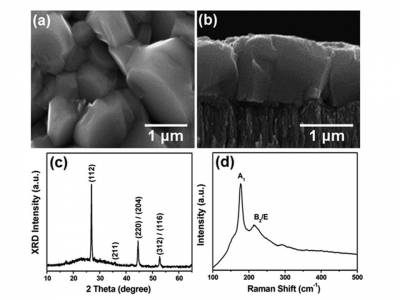The Science behind the research
Photovoltaic and solar thermal conversion of solar energy to electricity and heat respectively, has been of immense research interest due to zero pollution capability and uniform global availability of solar energy. Producing hydrogen by photoelectrochemical (PEC) water decomposition under solar illumination is much simpler and more environmentally friendly compared to catalytic reforming of hydrocarbon fuels. The characteristics of semiconductor materials used to form the photoelectrodes, including their bandgap, charge separation, interfacial charge-transfer, and charge-transport properties, have important roles in the solar energy conversion efficiency and the stability of the PEC water decomposition process. In addition, nanostructures can improve the light absorption and the photocurrent of PEC processes.
Ongoing research
In our group, we aim to develop low cost and high performance visible-light active, novel nano-catalysts for PEC splitting of water for solar hydrogen production. The approach consists of by layer-by-layer deposition of material combinations and surface modifications for achieving the desired characteristics.
Results
| Fig 1. Typical X-ray diffraction patterns of ZnO nanorods deposited on FTO glass. |
 |
The surface morphologies of the ZnO nanorods grown on ALD ZnO seed layer with different process parameters were characterized by SEM. The plane-view SEM images of the ZnO nanorods grown on FTO glass and glass at different seed layer process parameters are shown in Fig.2. The results show that the pristine ZnO NRs had a well-defined hexagonal morphology and uniform growth. In this array, the vertically alligned ZnO NRs were fabricated as the the seed layer deposited at 280℃. In this work, the ZnO nanorods were achieved as nanostructures from a fine grain ZnO seed layer by simple solution process.
| Fig2. SEM plane-view of a nanorod array on FTO glass with seed layer at (a) 200℃, 500 cycles, (b)240℃, 500cycles (c)280℃, 500cycles. Scale bar, 1 μm. |
 |
Potential applications
The vision for the future is that each residential house will have a PV solar panel system on the roof. During the day the sun will generate electricity and the excess, that is not currently used for heat, air conditioning, etc., will be converted to hydrogen and oxygen gas using only ordinary water and stored in local tanks. When needed, the hydrogen and oxygen gas will be fed into a fuel cell to generate electricity at night or on cloudy days. The electricity could be used for home appliances or to charge an electric car or anything else. The fuel cell by-product is again water which would be fed back into the water tank. Most likely a connection to the grid would be maintained for back up purposes.
Recent publications
- Wang, M., Chang, Y. S., Tsao, C. W., Fang, M. J., Hsu, Y. J., & Choy, K. L. (2019). Enhanced photoelectrochemical hydrogen generation in neutral electrolyte using non-vacuum processed CIGS photocathodes with an earth-abundant cobalt sulfide catalyst. Chemical Communications 55, 2465-2468 doi: 10.1039/C8CC09426H
 Close
Close

